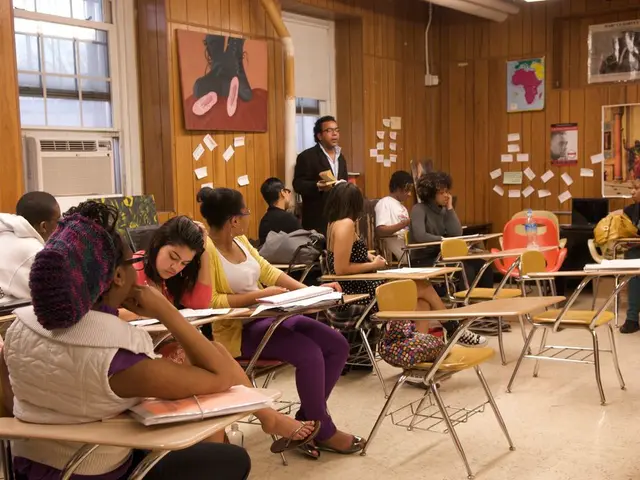Exploring the Advantages of Multisensory Education for Comprehensive Growth
In the realm of education, a revolutionary approach is gaining traction: multisensory learning. This innovative method leverages multiple senses – sight, sound, touch, and more – to enhance cognitive development and academic success, particularly benefiting children with learning disabilities.
The scientific basis for this effectiveness lies in the brain's ability to integrate information across multiple senses. This integration strengthens neural pathways, promotes brain plasticity, and supports more efficient learning. By engaging multiple sensory pathways simultaneously, such as seeing, hearing, and touching, we can create stronger and more extensive neural connections, enhancing memory retention and automatic retrieval of learned information.
Multisensory learning caters to diverse learning styles, benefiting students with diverse needs such as ADHD, dyslexia, or autism. For instance, kinesthetic learners, who learn best by doing things, benefit from kinesthetic elements in multisensory learning, like movement-based learning activities and physical engagement in learning. These elements boost skills like math and reading.
Moreover, multisensory learning is essential for a holistic and well-rounded education. It uses visual, auditory, tactile, kinesthetic, olfactory, and gustatory sensory experiences, making it a comprehensive approach for diverse learners.
One significant advantage of multisensory learning is its ability to increase engagement and motivation, further contributing to cognitive development and academic success. By making learning more interactive and engaging, multisensory approaches help maintain attention and motivation, ensuring that students remain focused and interested in their studies.
Research also suggests that multisensory learning is the most effective teaching method for children with learning difficulties. For example, children with dyscalculia benefit from simultaneous auditory, visual, and kinesthetic engagement when learning numbers, helping solidify abstract concepts that are otherwise difficult to grasp through single-sense instruction.
In special education settings, the multisensory approach has proven particularly beneficial. Schools like The Gateway School in New Jersey have been helping special education students since 1980 using multisensory learning. The NJ Special Needs School and OrbRom Center are other examples of institutions embracing this innovative approach.
Parents and teachers must work together for multisensory learning to succeed. By implementing multisensory teaching techniques at home and school, we can make learning spaces rich in sensory experiences, fostering a more effective educational experience for students.
In conclusion, multisensory learning capitalizes on the brain's inherent capacity for cross-modal sensory integration and neuroplasticity, providing multiple pathways for encoding and retrieving information. This leads to improved cognitive development and academic outcomes, particularly benefiting children with learning disabilities by addressing their unique sensory and processing challenges through structured, simultaneous stimulation across senses.
- Developing emotional intelligence, respect, and social skills in children is crucial for their overall growth and future success in the workplace-wellness, and it can be enhanced through multisensory learning.
- The integration of various medical-conditions, chronic-diseases, cancer, respiratory-conditions, digestive-health, eye-health, hearing, and health-and-wellness topics into education can help students understand them better and become more aware of their own health.
- In the context of nutrition, multisensory learning can aid in children's understanding of the importance of a balanced diet and the impact of food on their aging and overall fitness-and-exercise.
- By learning about sexual-health and skin-care at an early age, students can develop healthy habits that will serve them well as they grow older and navigate different stages of life.
- Multisensory learning can help students understand the complexities of autoimmune-disorders, environmental-science, and climate-change, fostering an appreciation for the environment and an understanding of the impact of human actions.
- In the realm of mental-health, multisensory learning can provide a safe environment for students to express their feelings, promoting emotional well-being and self-awareness.
- Men's-health topics can be introduced through multisensory learning, helping boys understand the importance of taking care of their health as they transition into adulthood.
- Skin-care and skin-conditions can be taught using multisensory methods, enabling students to learn about the importance of skincare practices and the signs of various skin issues.
- As part of their education-and-self-development, students can explore therapies-and-treatments for various health issues and learn about the potential benefits of alternative options like CBD.
- In the realm of neurological-disorders, multisensory learning can offer structured, simultaneous stimulation to help students with conditions like ADHD, dyslexia, or autism better understand and manage their challenges.
- Space-and-astronomy can be taught more effectively with multisensory learning, allowing students to visualize and better comprehend the vastness of the universe.
- Personal-growth can be nurtured through multisensory learning, as students engage with self-reflection activities and develop a deeper understanding of their own learning styles and abilities.
- Career-development can also benefit from multisensory learning, as students learn about job-search strategies, job skills, and professional development through various sensory experiences.
- In addition to traditional learning methods, multisensory learning can offer ways to teach students about learning challenges and the ways in which they can be overcome, such as weight-management and cardiovascular-health strategies.
- Many students can face challenges related to Medicare, and multisensory learning can offer a multifaceted approach to educating them on the benefits, eligibility, and processes involved.
- Beyond academics, multisensory learning can be applied to various aspects of life, such as learning about the various treatments and practices related to skin-care and other health issues.
- By focusing on the importance of self-care, multisensory learning can encourage students to take charge of their health, whether it's understanding their own medical-conditions, managing chronic-diseases, or embracing a lifestyle focused on fitness-and-exercise and nutrition.
- Parenting, a crucial responsibility, can be enhanced through multisensory learning, as parents learn about the unique needs and challenges of their children, particularly those with learning disabilities.
- In the realm of environmental-science, multisensory learning can foster a deep understanding of ways to combat climate-change, such as recycling and energy conservation.
- Through multisensory learning, students can explore various aspects of womens-health, engaging with topics like menstrual health, pregnancy, and reproductive health.
- As students grow older and embark on their own personal journeys, multisensory learning can provide them with the tools and knowledge needed to maintain mental-health, embrace self-care practices, and make informed decisions about their health and well-being.







